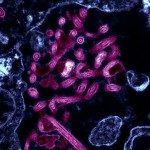Link to Pubmed [PMID] – 19453420
Influenza Other Respir Viruses 2008 Sep;2(5):155-63
BACKGROUND: Since 2004, H5N1 outbreaks have been recurrent in domestic poultry and humans in Cambodia. To date, seven human cases (100% CFR) and 22 outbreaks in poultry have been confirmed. Household ownership of backyard poultry (FAO Sector 4 poultry production) in rural Cambodia is high. An understanding of the extent and frequency of poultry handing behaviors in these settings is necessary to assess the risk associated with different practices and to formulate sensible recommendations to mitigate this risk. We collected new data from six geographic regions to examine patterns of human contact with poultry among rural farmers in Cambodia and identify populations with the highest potential exposure to H5N1.
METHODS AND FINDINGS: A cross-sectional survey was undertaken in which 3,600 backyard poultry owners from 115 randomly selected villages in six provinces throughout Cambodia were interviewed. Using risk assessment methods, patterns of contact with poultry as surrogate measures of exposure to H5N1 were used to generate risk indices of potential H5N1 transmission to different populations in contact with poultry. Estimates of human exposure risk for each study participant (n = 3600) were obtained by multiplying each reported practice with a transmission risk-weighting factor and summing these over all practices reported by each individual. Exposure risk estimates were then examined stratified by age and gender. Subjects reported high contact with domestic poultry (chickens and ducks) through the daily care and food preparation practices, however contact patterns varied by gender and age. Males between the ages of 26-40 reported practices of contact with poultry that give rise to the highest H5N1 transmission risk potential, followed closely by males between the ages of 16-25. Overall, males had a higher exposure risk potential than females across all age groups (p < 0.001).
CONCLUSIONS: Our results demonstrate that most of the population in rural Cambodia is in frequent contact with domestic poultry. About half of the population in this study carried out on a regular basis at least one of the practices considered to be high risk for the effective transmission if the bird is infected. There was however substantial variation in the frequency of different practices and thus the potential risk of transmission of H5N1 from poultry to humans is not uniform across age and gender even amongst populations living in close proximity to poultry.

